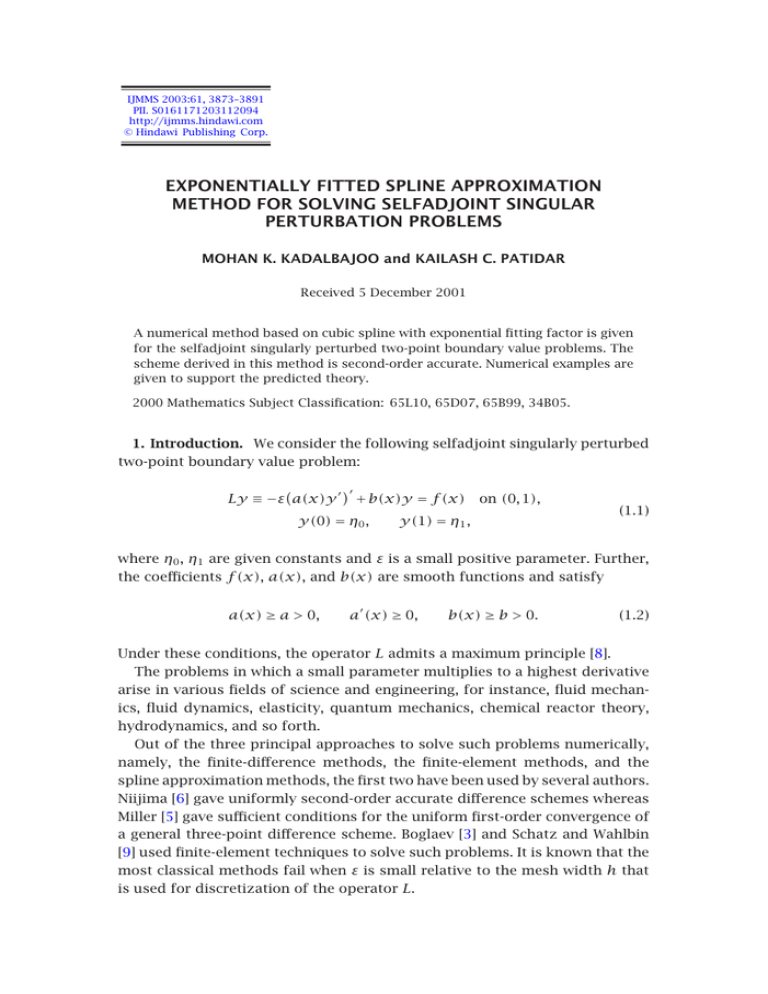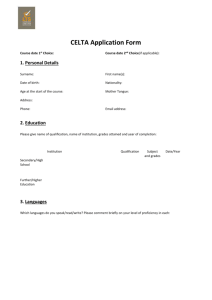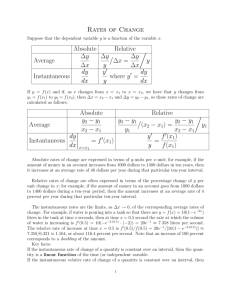EXPONENTIALLY FITTED SPLINE APPROXIMATION METHOD FOR SOLVING SELFADJOINT SINGULAR PERTURBATION PROBLEMS
advertisement

IJMMS 2003:61, 3873–3891 PII. S0161171203112094 http://ijmms.hindawi.com © Hindawi Publishing Corp. EXPONENTIALLY FITTED SPLINE APPROXIMATION METHOD FOR SOLVING SELFADJOINT SINGULAR PERTURBATION PROBLEMS MOHAN K. KADALBAJOO and KAILASH C. PATIDAR Received 5 December 2001 A numerical method based on cubic spline with exponential fitting factor is given for the selfadjoint singularly perturbed two-point boundary value problems. The scheme derived in this method is second-order accurate. Numerical examples are given to support the predicted theory. 2000 Mathematics Subject Classification: 65L10, 65D07, 65B99, 34B05. 1. Introduction. We consider the following selfadjoint singularly perturbed two-point boundary value problem: Ly ≡ −ε a(x)y + b(x)y = f (x) y(0) = η0 , on (0, 1), y(1) = η1 , (1.1) where η0 , η1 are given constants and ε is a small positive parameter. Further, the coefficients f (x), a(x), and b(x) are smooth functions and satisfy a(x) ≥ a > 0, a (x) ≥ 0, b(x) ≥ b > 0. (1.2) Under these conditions, the operator L admits a maximum principle [8]. The problems in which a small parameter multiplies to a highest derivative arise in various fields of science and engineering, for instance, fluid mechanics, fluid dynamics, elasticity, quantum mechanics, chemical reactor theory, hydrodynamics, and so forth. Out of the three principal approaches to solve such problems numerically, namely, the finite-difference methods, the finite-element methods, and the spline approximation methods, the first two have been used by several authors. Niijima [6] gave uniformly second-order accurate difference schemes whereas Miller [5] gave sufficient conditions for the uniform first-order convergence of a general three-point difference scheme. Boglaev [3] and Schatz and Wahlbin [9] used finite-element techniques to solve such problems. It is known that the most classical methods fail when ε is small relative to the mesh width h that is used for discretization of the operator L. 3874 M. K. KADALBAJOO AND K. C. PATIDAR In this paper, we have used the third approach, namely, the spline approximation method, to solve problems of type (1.1). There are two possibilities to obtain small truncation error inside the boundary layer(s). The first is to choose a fine mesh there, whereas the second one is to choose a difference formula reflecting the behaviour of the solution(s) inside the boundary layer(s). The present work deals with the second approach, whereas the first one is currently under the investigation of the authors. We have reduced the original problem (i.e., problem (1.1)) to the normal form. In the normalized form, we replace the perturbation parameter ε affecting the highest derivative by a fitting factor σ (x, ε). Using cubic spline, this factor is determined in such a way that the truncation error of the corresponding scheme for the boundary layer function(s), in the case of constant coefficients, should be equal to zero. This procedure is known as the exponential fitting or the introducing of artificial viscosity [2, 4]. By making use of the continuity of the first-order derivative of the spline function, the resulting spline difference scheme gives a tridiagonal system which can be solved efficiently by the wellknown algorithms. In Section 2, we give a brief description of the method. The derivation of the difference scheme has been given in Section 3. The fitting factor is determined in Section 4, whereas the second-order accuracy of the method is shown in Section 5. To demonstrate the applicability of the proposed method, four numerical examples have been solved in Section 6 and the results are presented along with their comparison with those obtained by other authors. Finally, the discussion on these numerical results, along with some comparisons with the results obtained earlier by others, is presented in Section 7. 2. Description of the method. Rewrite (1.1) as y + P (x)y + Q(x)y = R(x), (2.1) where P (x) = a (x) , a(x) Q(x) = − b(x) , εa(x) R(x) = − f (x) . εa(x) (2.2) Let y(x) = U (x)V (x), (2.3) and transform (2.1) into the normal form, that is, V + A(x)V = B(x), (2.4) EXPONENTIALLY FITTED SPLINE APPROXIMATION METHOD . . . 3875 2 1 1 A(x) = Q(x) − P (x) − P (x) , 2 4 1 P (x)dx , B(x) = R(x) exp 2 1 U (x) = exp − P (x)dx , x ∈ (0, 1), 2 (2.5) where with V (0) = y(0) = α0 , U (0) V (1) = y(1) = α1 , U (1) α0 , α1 ∈ R. (2.6) Multiplying (2.4) throughout by −ε (where 0 < ε ≤ 1), we get −εV + W (x)V = Z(x), V (0) = α0 , (2.7) V (1) = α1 , where W (x) = −εA(x), Z(x) = −εB(x). (2.8) We define the fitting comparison problem associated with (2.7) by −σ (x, ε)V + W (x)V = Z(x), V (0) = α0 , (2.9) V (1) = α1 , where σ (x, ε) is an exponential fitting factor which is to be determined subsequently. The approximate solution of problem (2.9) is sought in the form of the cubic spline function Sj (x), which is defined as follows: let x0 = 0, xj = x0 + jh, j = 1(1)n, h = xj − xj−1 , xn = 1. (2.10) For the values V (x0 ), V (x1 ), . . . , V (xn ), there exists an interpolating cubic spline with the following properties: (i) Sj (x) coincides with a polynomial of degree 3 on each interval [xj−1 , xj], j = 1(1)n; (ii) Sj (x) ∈ C 2 [0, 1]; (iii) Sj (xj ) = V (xj ), j = 0(1)n. Hence, analogous to [1], the cubic spline can be given as 3 3 xj − x x − xj−1 Sj (x) = Mj−1 + Mj 6h 6h 2 xj − x x − xj−1 h Mj−1 h2 Mj + Vj − , + Vj−1 − 6 h 6 h (2.11) 3876 M. K. KADALBAJOO AND K. C. PATIDAR where x ∈ xj−1 , xj , h = xj − xj−1 , j = 1, 2, . . . , n, Mj = Sj xj , j = 0, 1, . . . , n. (2.12) Using this spline function, we will derive the difference scheme in Section 3, which will give us the approximate solution of V (x). Since U(x) is known, therefore the solution to the original problem will be obtained using (2.3). 3. Derivation of the scheme. Differentiating (2.11) and denoting the approximate solution to V (x) by ν(x), we get 2 2 xj − x x − xj−1 Mj−1 + Mj Sj (x) = − 2h 2h Mj − Mj−1 νj − νj−1 − h. + h 6 (3.1) Since Sj (x) ∈ C 2 [0, 1], therefore we must have xj . Sj xj = Sj+1 (3.2) Using (3.1), (3.2), and (2.9), we obtain the difference scheme Rνj = QZj , j = 1, 2, . . . , n − 1, (3.3) where rj− = −1 1− h2 Wj−1 6σj− Rνj = rj− νj−1 + rjc νj + rj+ νj+1 , (3.4) QZj = qj− Zj−1 + qjc Zj + qj+ Zj+1 , (3.5) ν0 = α0 , 1 , h qj− = νn = α1 , h2 Wj+1 1 rj+ = −1 1− , 6σj+ h h , 6σj− (3.6) h2 Wj 1 rjc = 2 1+ 3σjc h (3.7) qj+ = h , 6σj+ qjc = 2h , 3σjc (3.8) where σj− = σj−1 , σj+ = σj+1 , σjc = σj , and σj is to be determined. Remark 3.1. The scheme without using fitting factor will be given by rj− = −1 h2 Wj−1 1− 6ε 1 , h qj− = rj+ = −1 h , 6ε h2 Wj+1 1− 6ε qj+ = h , 6ε 1 , h qjc = 2h . 3ε rjc = 2 h2 Wj 1+ 3ε 1 , h (3.9) EXPONENTIALLY FITTED SPLINE APPROXIMATION METHOD . . . 3877 4. Determination of the fitting factor. In order to get a suitable fitting factor σ (x, ε), we will use the following lemma. Lemma 4.1 [4]. Let V (x) ∈ C 4 [0, 1]. Let W (0) = W (1) = 0. Then the solution of problem (2.7) has the form V (x) = d(x) + e(x) + g(x), (4.1) where W (0) 1/2 , ε W (1) 1/2 e(x) = q1 exp − (1 − x) , ε d(x) = q0 exp − x (4.2) q0 and q1 are bounded functions of ε independent of x and (k) g (x) ≤ N 1 + (ε)1−k/2 , k = 0, 1, 2, 3, 4 (4.3) N is a constant independent of ε. The matrix of the system (3.3) is inverse monotone if h2 Wi /6σi ≤ 1, i = j, j ± 1. Thus, we take a fitting factor in the following way: σj− = h2 Wj−1 µ(ρ), 6 σj+ = h2 Wj+1 µ(ρ), 6 σjc = h2 Wj µ(ρ), 6 (4.4) where µ(ρ) (with ρ at xj given by ρj = Wj /ε) is to be determined. We require that the truncation error for the boundary layer functions should be equal to zero when W (x) = W = constant. From the condition Rdj = 0 for W (x) = W = constant, we have µ(ρ) = 1 + 3 . 2 sin h2 (ρh/2) (4.5) The condition Rej = 0 for W (x) = W = constant will give the same µ(ρ). Therefore, we define 3 , 2 sin h2 (ρh/2) 3 , µ ρj = 1 + 2 sin h2 (ρj h/2) µ(ρ) = 1 + when W (x) = W = constant, (4.6) when W (x) ≠ constant . Hence, the variable fitting factor σj is defined as σj = h2 Wj µ ρj . 6 (4.7) 3878 M. K. KADALBAJOO AND K. C. PATIDAR 5. Proof of the uniform convergence. Throughout the paper, M will denote a positive constant which may take different values in different equations (inequalities) but are always independent of h and ε. The scheme (3.3), (3.8) can be written in the matrix form Aν = Z, (5.1) where A is a matrix of the system (3.3) and ν and Z are corresponding vectors. Now, the local truncation error τj (φ) of the scheme (3.3) is defined by τj (φ) = Rφj − Q(Lφ)j , (5.2) where φ(x) is an arbitrary sufficiently smooth function. Therefore, τj (V ) = RVj − Q(LV )j = R Vj − νj ⇒ R Vj − νj = τj (V ) ⇒ max Vj − νj ≤ A−1 max τj (V ). j (5.3) j In order to estimate the values |Vj − νj |, we will estimate the truncation error τj (V ) and the norm of the matrix A−1 . From (4.7), it is obvious that 0 ≤ σj ≤ Mh2 ⇒ σj − ε ≤ Mh2 for ε ≤ Ch2 , (5.4) where C is some positive constant. Now, for the case Ch2 ≤ ε, we see that σj − ε = 2 h2 Wj hρj /2 − 1 ⇒ σj − ε| ≤ Mh2 +ε 6 sinh2 hρj /2 for Ch2 ≤ ε. (5.5) Hence, σj − ε ≤ Mh2 , (5.6) that is, σj approximates ε with the error O(h2 ). Estimation of truncation error and the norm of A−1 . From Lemma 4.1, we have τj (V ) = τj (d) + τj (e) + τj (g). We will estimate separately the parts of τj (V ). First, we consider the case in which Ch2 ≤ ε. (5.7) EXPONENTIALLY FITTED SPLINE APPROXIMATION METHOD . . . 3879 We will start with d(x). We calculate Rdj = rj− dj−1 + rjc dj + rj+ dj+1 Q(Ld)j = (5.8) qj− Zj−1 + qjc Zj + qj+ Zj+1 = qj− − εd j−1 + Wj−1 dj−1 + + qjc − εd j + Wj dj + qj − εdj+1 + Wj+1 dj+1 . (5.9) Now, from Lemma 4.1, we have W (0) d(x) = q0 exp − x ε 1/2 (5.10) implies W 0 , dj−1 = dj exp h dj+1 = dj exp − h ε W0 W0 W0 W0 dj exp h dj exp − h dj−1 = , dj+1 = , ε ε ε ε W0 dj . = d j ε W0 , ε (5.11) (5.12) (5.13) Putting all these expressions into (5.8) and (5.9), and since τj (d) = Rdj − Q(Ld)j , (5.14) we get τj (d) = dj−1 1 hW0 − + h 6σj− + dj 2 2hW0 + h 3σjc + dj+1 1 hW0 − + . h 6σj+ (5.15) From (5.6), σj = ε +O(h2 ), and using the above expressions for dj−1 and dj+1 , we have 3 τj (d) ≤ Mh dj . 2 ε (5.16) But the expression for d(x) involves q0 in the numerator, which is a bounded function of ε independent of x. Therefore, we get 3 τj (d) ≤ Mh . ε (5.17) Now W (1) e(x) = q1 exp − (1 − x) ε 1/2 (5.18) 3880 M. K. KADALBAJOO AND K. C. PATIDAR implies W 1 , ej−1 = ej exp − h ej+1 = ej exp h ε W1 W1 W1 W1 ej exp − h , ej+1 = ej exp h , ej−1 = ε ε ε ε W1 ej , ej = ε W1 , ε (5.19) (5.20) (5.21) and the similar construction as was for d(x) will give us 3 τj (e) ≤ Mh . ε (5.22) τj (g) = Rgj − Q(Lg)j (5.23) Now, implies εh 1 τj (g) = − gj−1 − 2gj + gj+1 + h 6 gj−1 σj− + 4gj σjc + gj+1 σj+ . (5.24) Expanding gj−1 , gj+1 , and their derivatives in terms of gj and its derivatives, and using (5.6), we get τj (g) ≤ Mh3 gj(iv) . (5.25) Therefore, using Lemma 4.1, we obtain 3 τj (g) ≤ Mh . ε (5.26) From (5.17), (5.22), and (5.26), we have 3 τj (V ) ≤ Mh ε when Ch2 ≤ ε. (5.27) Now we consider the case in which Ch2 ≥ ε. We introduce the notations rj− = rj− Wj−1 , qj− = qj− Wj−1 , rj+ = rj+ Wj+1 , qj+ = qj+ Wj+1 , rjc = rjc Wj , qjc = qjc Wj . (5.28) Since we have determined σ (x, ε) in such a way that the truncation error for the boundary layer function(s) is equal to zero in the case of W (x) = W = constant, EXPONENTIALLY FITTED SPLINE APPROXIMATION METHOD . . . 3881 thus τj (d) = 0 when W (x) = W = constant. We will denote this expression by τj (d). Therefore, τj (d) = τj (d) − τj (d) Wj−1 − W0 dj−1 = rj− Wj−1 − rj− W0 − qj− Wj−1 − qj− W0 + rjc Wj − rjc W0 − qjc Wj − qjc W0 Wj − W0 dj Wj+1 − W0 dj+1 . + rj+ Wj+1 − rj+ W0 − qj+ Wj+1 − qj+ W0 (5.29) Using (3.8) and (5.6), and since Wj−1 − W0 ≤ Mx 2 , j−1 Wj − W0 ≤ Mx 2 , Wj+1 − W0 ≤ Mx 2 , j+1 (5.30) j we obtain τj (d) ≤ M x 2 dj−1 + x 2 dj + x 2 dj+1 . j j+1 h j−1 (5.31) Now, using the fact that (see, e.g., Doolan et al. [4]) ε cx cx ≤M exp − x exp − ε c 2ε (5.32) and dj ’s involve q0 which is a bounded function of ε, we obtain 2 dj−1 ≤ Mε2 , xj−1 xj2 dj ≤ Mε2 , 2 xj+1 dj+1 ≤ Mε2 . (5.33) Hence, 2 τj (d) ≤ Mε . h (5.34) ε < 1 ⇒ ε2 < ε, (5.35) τj (d) ≤ Mε h (5.36) But therefore, implies τj (d) ≤ Mh since ε ≤ Ch2 . (5.37) Similarly, we obtain τj (e) ≤ Mh. (5.38) 3882 M. K. KADALBAJOO AND K. C. PATIDAR Now, for τj (g), we use the form τj (g) = ε gj−1 + 4gj + gj+1 + hg (ξ) : xj−1 < ξ < xj+1 . h (5.39) Therefore, using Lemma 4.1, we obtain τj (g) ≤ Mh. (5.40) From (5.37), (5.38), and (5.40), we have τj (V ) ≤ Mh. (5.41) Estimate of A−1 . Following Varah [10], we see that 1 hWj−1 2 2hWj 1 hWj+1 − r − + r c − r + = − + + + − j j j h 6σj− h 3σjc h 6σj+ 4 h 1 = h − 6 Wj−1 − 4Wj + Wj+1 ε + O h2 (5.42) using (5.6), M1 h ε , − r − + r c − r + ≥ j j j M1 , h Ch2 ≤ ε, (5.43) Ch2 ≥ ε, implies M2 ε , −1 A ≤ h M h, 2 Ch2 ≤ ε, (5.44) Ch2 ≥ ε, where M1 and M2 (= 1/M1 ) are constants independent of h and ε. From (5.3), (5.27), (5.41), and (5.44), we have the following theorem. Theorem 5.1. Let W (x), Z(x) ∈ C 2 [0, 1], W (x) ≥ W > 0, and W (0) = W (1) = 0. Let νj , j = 0, 1, . . . , n be the approximate solution of (2.7), obtained using (3.3) and (3.8). Then, there is a constant M independent of ε and h such that max V xj − νj ≤ Mh2 . j (5.45) 6. Test examples and numerical results. In this section, we present some numerical results which illustrate Theorem 5.1. EXPONENTIALLY FITTED SPLINE APPROXIMATION METHOD . . . 3883 Example 6.1 [11]. Consider problem (1.1) with a(x) = 1, b(x) = 1 + x(1 − x) √ 1−x f (x) = 1 + x(1 − x) + 2 ε − x 2 (1 − x) exp − √ ε √ x + 2 ε − x(1 − x)2 exp − √ ε y(0) = 0, y(1) = 0. (6.1) Its exact solution is given by 1−x x . y(x) = 1 + (x − 1) exp − √ − x exp − √ ε ε (6.2) Example 6.2 [7]. Consider problem (1.1) with √ 4 1 + ε(x + 1) , a(x) = 1, b(x) = 4 (x + 1) √ 4 4π x 2 f (x) = − ε(x + 1) + 4π ε cos 1 + (x + 1)4 x +1 √ 3 1 + ε(x + 1) 4π x √ , − 2π ε(x + 1) sin + x +1 1 − exp − 1/ ε y(0) = 2, y(1) = −1. (6.3) Its exact solution is given by y(x) = − cos √ √ 3 exp − 2x/ ε(x + 1) − exp − 1/ ε 4π x √ . + x +1 1 − exp − 1/ ε (6.4) Example 6.3 [4]. Consider problem (1.1) with cos x b(x) = , (3 − x)3 2 1 x− f (x) = 4 3x 2 − 3x + 1 +2 , 2 y(0) = −1, y(1) = 0. a(x) = 1 + x 2 , (6.5) Its exact solution is not available. Example 6.4 [9]. Consider problem (1.1) with 1 a(x) = 1, b(x) = , ε 1 1 x − 1 − x exp − √ , f (x) = ε ε y(0) = 0, y(1) = 0. (6.6) Its exact solution is given by 1 x y(x) = x − 1 − x exp − √ + exp − √ . ε ε (6.7) 3884 M. K. KADALBAJOO AND K. C. PATIDAR Table 6.1. Numerical results for Example 6.1 (maximum error) without using fitting factor. ε n = 16 n = 32 n = 64 n = 128 n = 256 n = 512 1/8 1/16 1/32 1/64 1/128 1/256 1/512 1/1024 1/2048 0.15E-02 0.20E-02 0.29E-02 0.51E-02 0.95E-02 0.19E-01 0.38E-01 0.67E-01 0.11E+00 0.36E-03 0.49E-03 0.73E-03 0.13E-02 0.23E-02 0.45E-02 0.85E-02 0.18E-01 0.36E-01 0.91E-04 0.12E-03 0.18E-03 0.31E-03 0.58E-03 0.11E-02 0.21E-02 0.42E-02 0.81E-02 0.23E-04 0.31E-04 0.45E-04 0.78E-04 0.15E-03 0.28E-03 0.53E-03 0.10E-02 0.20E-02 0.57E-05 0.77E-05 0.11E-04 0.20E-04 0.36E-04 0.69E-04 0.13E-03 0.26E-03 0.50E-03 0.14E-05 0.19E-05 0.28E-05 0.49E-05 0.91E-05 0.17E-04 0.33E-04 0.64E-04 0.13E-03 Table 6.2. Numerical results for Example 6.1 (maximum error) using fitting factor. ε n = 16 n = 32 n = 64 n = 128 n = 256 n = 512 1/8 1/16 1/32 1/64 1/128 1/256 1/512 1/1024 1/2048 0.32E-03 0.35E-03 0.40E-03 0.53E-03 0.83E-03 0.13E-02 0.18E-02 0.25E-02 0.33E-02 0.80E-04 0.86E-04 0.99E-04 0.13E-03 0.19E-03 0.26E-03 0.42E-03 0.62E-03 0.88E-03 0.20E-04 0.21E-04 0.25E-04 0.33E-04 0.46E-04 0.66E-04 0.95E-04 0.13E-03 0.21E-03 0.50E-05 0.53E-05 0.62E-05 0.82E-05 0.12E-04 0.16E-04 0.23E-04 0.33E-04 0.47E-04 0.12E-05 0.13E-05 0.15E-05 0.21E-05 0.29E-05 0.41E-05 0.58E-05 0.81E-05 0.12E-04 0.31E-06 0.33E-06 0.39E-06 0.51E-06 0.72E-06 0.10E-05 0.14E-05 0.20E-05 0.29E-05 Table 6.3. Numerical results for Example 6.1 (rate of convergence) using fitting factor n = 16, 32, 64, 128, 256. ε r (0) r (1) r (2) r (3) r (4) Avg 1/8 1/16 1/32 1/64 1/128 1/256 1/512 1/1024 1/2048 0.20E+01 0.20E+01 0.20E+01 0.20E+01 0.22E+01 0.23E+01 0.22E+01 0.21E+01 0.21E+01 0.20E+01 0.20E+01 0.20E+01 0.20E+01 0.20E+01 0.20E+01 0.22E+01 0.23E+01 0.22E+01 0.20E+01 0.20E+01 0.20E+01 0.20E+01 0.20E+01 0.20E+01 0.20E+01 0.20E+01 0.22E+01 0.20E+01 0.20E+01 0.20E+01 0.20E+01 0.20E+01 0.20E+01 0.20E+01 0.20E+01 0.20E+01 0.20E+01 0.20E+01 0.20E+01 0.20E+01 0.20E+01 0.20E+01 0.20E+01 0.20E+01 0.20E+01 0.20E+01 0.20E+01 0.20E+01 0.20E+01 0.20E+01 0.21E+01 0.21E+01 0.21E+01 0.21E+01 Tables 6.1, 6.2, 6.5, and 6.8 contain the maximum errors at all the mesh points: max y(xj ) − ν xj j (6.8) 3885 EXPONENTIALLY FITTED SPLINE APPROXIMATION METHOD . . . Table 6.4. Numerical results of O’Riordan and Stynes for Example 6.2 (maximum error). ε=1 ε = (1/n)0.25 ε = (1/n)0.5 ε = (1/n)0.75 ε = (1/n) 8 0.42E+00 0.38E+00 0.33E+00 0.28E+00 0.25E+00 16 0.11E+00 0.95E-01 0.78E-01 0.66E-01 0.64E-01 32 0.27E-01 0.23E-01 0.18E-01 0.16E-01 0.17E-01 64 0.69E-02 0.56E-02 0.42E-02 0.40E-02 0.42E-02 128 0.17E-02 0.13E-02 0.10E-02 0.10E-02 0.13E-02 256 0.43E-03 0.31E-03 0.25E-03 0.26E-03 0.37E-03 512 0.11E-03 0.74E-04 0.63E-04 0.73E-04 0.10E-03 n Table 6.5. Numerical results for Example 6.2 (maximum error). ε=1 ε = (1/n)0.25 ε = (1/n)0.5 ε = (1/n)0.75 ε = (1/n) 8 0.20E+00 0.18E+00 0.14E+00 0.10E+00 0.10E+00 n 16 0.54E-01 0.47E-01 0.38E-01 0.26E-01 0.22E-01 32 0.14E-01 0.12E-01 0.95E-02 0.64E-02 0.92E-02 64 0.35E-02 0.30E-02 0.24E-02 0.16E-02 0.27E-02 128 0.86E-03 0.76E-03 0.60E-03 0.40E-03 0.66E-03 256 0.22E-03 0.19E-03 0.15E-03 0.10E-03 0.16E-03 512 0.54E-04 0.47E-04 0.37E-04 0.25E-04 0.41E-04 j ) is the approximate solution of (1.1) obtained for different n and ε, where ν(x via (2.7) and (2.3). Table 6.6 contains maximum errors based on the double-mesh principle (Doolan et al. [4]) (as for Example 6.3, the exact solution is not available): 2n , max νjn − ν2j 0≤j≤n n = 8, 16, 32, 64, 128, 256. (6.9) Tables 6.3 and 6.7 contain the numerical rate of uniform convergence for Examples 6.1 and 6.3, respectively, which is determined as in [4]: rk,ε = log2 zk,ε , zk+1,ε k = 0, 1, 2, . . . , (6.10) where h/2k h/2k+1 , − ν2j zk,ε = max νj j h/2k and νj k = 0, 1, 2, . . . , denotes the value of νj for the mesh length h/2k . (6.11) 3886 M. K. KADALBAJOO AND K. C. PATIDAR Table 6.6. Numerical results for Example 6.3 (maximum error). ε n=8 n = 16 n = 32 n = 64 n = 128 n = 256 n = 512 1/2 0.10E-01 0.25E-02 0.63E-03 0.16E-03 0.39E-04 0.98E-05 0.24E-05 1/4 0.20E-01 0.49E-02 0.12E-02 0.31E-03 0.77E-04 0.19E-04 0.48E-05 1/8 0.39E-01 0.96E-02 0.24E-02 0.60E-03 0.15E-03 0.38E-04 0.94E-05 1/16 0.75E-01 0.19E-01 0.47E-02 0.12E-02 0.29E-03 0.73E-04 0.18E-04 1/32 0.14E+00 0.35E-01 0.88E-02 0.22E-02 0.55E-03 0.14E-03 0.34E-04 1/64 0.25E+00 0.63E-01 0.16E-01 0.40E-02 0.99E-03 0.25E-03 0.62E-04 1/128 0.42E+00 0.11E+00 0.26E-01 0.66E-02 0.16E-02 0.41E-03 0.10E-03 1/256 0.64E+00 0.16E+00 0.40E-01 0.99E-02 0.25E-02 0.62E-03 0.15E-03 Table 6.7. Numerical results for Example 6.3 (rate of convergence), n = 8, 16, 32, 64, 128. ε r (0) r (1) r (2) r (3) r (4) Avg 1/2 0.20E+01 0.20E+01 0.20E+01 0.20E+01 0.20E+01 0.20E+01 1/4 0.20E+01 0.20E+01 0.20E+01 0.20E+01 0.20E+01 0.20E+01 1/8 0.20E+01 0.20E+01 0.20E+01 0.20E+01 0.20E+01 0.20E+01 1/16 0.20E+01 0.20E+01 0.20E+01 0.20E+01 0.20E+01 0.20E+01 1/32 0.20E+01 0.20E+01 0.20E+01 0.20E+01 0.20E+01 0.20E+01 1/64 0.20E+01 0.20E+01 0.20E+01 0.20E+01 0.20E+01 0.20E+01 1/128 0.20E+01 0.20E+01 0.20E+01 0.20E+01 0.20E+01 0.20E+01 1/256 0.20E+01 0.20E+01 0.20E+01 0.20E+01 0.20E+01 0.20E+01 Table 6.8. Numerical results for Example 6.4 (maximum error). Schatz’s: PL∗ [9] ε Schatz’s: HC∗∗ [9] Our results n = 20 n = 40 n = 20 n = 40 n = 20 n = 40 5−1 0.96E-03 0.24E-03 0.34E-05 0.26E-06 0.18E-14 0.60E-14 5−2 0.27E-01 0.60E-02 0.83E-03 0.90E-04 0.33E-15 0.56E-15 5−3 0.21E+00 0.12E+00 0.33E-01 0.94E-02 0.22E-15 0.22E-15 5−4 0.26E+00 0.26E+00 0.78E-01 0.68E-01 0.22E-15 0.22E-15 5−5 0.27E+00 0.27E+00 0.82E-01 0.82E-01 0.11E-15 0.11E-15 5−6 0.27E+00 0.27E+00 0.82E-01 0.82E-01 0.11E-15 0.11E-15 ∗ PL: piecewise linears Hermite cubics. ∗∗ HC: 7. Discussion. We have described a numerical method for solving selfadjoint singular perturbation problem using cubic spline with exponential fitting. It is a practical method and can easily be implemented on a computer to solve such problems. The method has been analyzed for convergence. Four EXPONENTIALLY FITTED SPLINE APPROXIMATION METHOD . . . 1 0.9 0.8 0.7 0.6 0.5 0.4 0.3 0.2 0.1 0 0 0.2 0.4 0.6 0.8 3887 1 Exact sol. Approx. sol. for h = 1/20 Figure 7.1. Exact and approximate solutions of Example 6.1 for ε = 0.001 without using fitting factor. 1 0.9 0.8 0.7 0.6 0.5 0.4 0.3 0.2 0.1 0 0 0.2 0.4 0.6 0.8 1 Exact sol. Approx. sol. for h = 1/20 Figure 7.2. Exact and approximate solutions of Example 6.1 for ε = 0.001 using fitting factor. examples have been solved to demonstrate the applicability of the proposed method. For Examples 6.1 and 6.3, we have computed the rate of convergence, see Tables 6.3 and 6.7 which show the uniform second-order convergence as predicted in the theory. The same can be seen for the other examples also. As is seen from Tables 6.1 and 6.2, the results obtained using fitting factor are better than those without using fitting factor. Example 6.2 has been solved earlier by O’Riordan and Stynes [7]. We obtain better results than those in [7]. Using finite-element techniques, Schatz and 3888 M. K. KADALBAJOO AND K. C. PATIDAR 1 0.8 0.6 0.4 0.2 0 0 0.2 0.4 0.6 0.8 1 Exact sol. Approx. sol. for h = 1/20 Figure 7.3. Exact and approximate solutions of Example 6.1 for ε = 0.0005 without using fitting factor. 1 0.8 0.6 0.4 0.2 0 0 0.2 0.4 0.6 0.8 1 Exact sol. Approx. sol. for h = 1/20 Figure 7.4. Exact and approximate solutions of Example 6.1 for ε = 0.0005 using fitting factor. Wahlbin [9] have solved Example 6.4. Table 6.8 shows (quite graphically) how badly standard methods can perform. To further corroborate the applicability of the proposed method, graphs have been plotted for Examples 6.1 and 6.2 for values of x ∈ [0, 1] versus the computed (termed as approximate) solution obtained at different values of x for a fixed ε. For each plot, we took n = 20 and 40 for Examples 6.1 and 6.2, respectively. Figures 7.1 and 7.3 are the graphs without using fitting factor for Example 6.1 for ε = 0.001 and ε = 0.0005, respectively, whereas Figures 7.2 and 7.4 are the graphs which are plotted using fitting factor for the same value of n and ε = 0.001 and ε = 0.0005, respectively. Similarly Figures 7.5 and 7.7 EXPONENTIALLY FITTED SPLINE APPROXIMATION METHOD . . . 3889 2 1.5 1 0.5 0 −0.5 −1 0 0.2 0.4 0.6 0.8 1 Exact sol. Approx. sol. for h = 1/40 Figure 7.5. Exact and approximate solutions of Example 6.2 for ε = 0.001 without using fitting factor. 2 1.5 1 0.5 0 −0.5 −1 0 0.2 0.4 0.6 0.8 1 Exact sol. Approx. sol. for h = 1/40 Figure 7.6. Exact and approximate solutions of Example 6.2 for ε = 0.001 using fitting factor. are graphs without using fitting factor for Example 6.2 for ε = 0.001 and ε = 0.0001, respectively, whereas Figures 7.6 and 7.8 are graphs which are plotted using fitting factor for the same value of n and ε = 0.001 and ε = 0.0001, respectively. It can be seen from Figures 7.1, 7.3, 7.5, and 7.7 that the exact and approximate solutions without using fitting factor deviate from each other in the boundary layer regions for smaller ε. To control these fluctuations, we used fitting-factor technique and the resulting behaviour of these two solutions can be seen from Figures 7.2, 7.4, 7.6, and 7.8. The similar observation can be made for the other examples also. 3890 M. K. KADALBAJOO AND K. C. PATIDAR 2 1.5 1 0.5 0 −0.5 −1 −1.5 −2 0 0.2 0.4 0.6 0.8 1 Exact sol. Approx. sol. for h = 1/40 Figure 7.7. Exact and approximate solutions of Example 6.2 for ε = 0.0001 without using fitting factor. 2 1.5 1 0.5 0 −0.5 −1 0 0.2 0.4 0.6 0.8 1 Exact sol. Approx. sol. for h = 1/40 Figure 7.8. Exact and approximate solutions of Example 6.2 for ε = 0.0001 using fitting factor. Finally, we would like to remark that we have replaced ε by σ (x, ε) in the normalized form and not in the original selfadjoint problem (i.e., problem (1.1)), with a(x) ≠ constant because in that case ε is a multiple of both the second and first derivative terms which will cause implicit expressions whereas in normalized form, ε is multiplied with the second derivative term only and hence, the fitting-factor technique on the normalized form can easily be implemented. This shows the importance of reducing the original selfadjoint problem to normal form. EXPONENTIALLY FITTED SPLINE APPROXIMATION METHOD . . . 3891 Acknowledgement. The computations reported in this paper were done on Silicon Graphics Origin 200 (dual processor) Operating System (in Fortran 77 in double precision with 16 significant figures) at the Indian Institute of Technology Kanpur. References [1] [2] [3] [4] [5] [6] [7] [8] [9] [10] [11] J. H. Ahlberg, E. N. Nilson, and J. L. Walsh, The Theory of Splines and Their Applications, Academic Press, New York, 1967. A. E. Berger, J. M. Solomon, M. Ciment, S. H. Leventhal, and B. C. Weinberg, Generalized OCI schemes for boundary layer problems, Math. Comp. 35 (1980), no. 151, 695–731. I. P. Boglaev, A variational difference scheme for a boundary value problem with a small parameter in the highest derivative, U.S.S.R. Comput. Math. and Math. Phys. 21 (1981), no. 4, 71–81. E. P. Doolan, J. J. H. Miller, and W. H. A. Schilders, Uniform Numerical Methods for Problems with Initial and Boundary Layers, Boole Press, Dublin, 1980. J. J. H. Miller, On the convergence, uniformly in ε, of difference schemes for a two point boundary singular perturbation problem, Numerical Analysis of Singular Perturbation Problems (Proc. Conf., Math. Inst., Catholic Univ., Nijmegen, 1978), Academic Press, New York, 1979, pp. 467–474. K. Niijima, On a three-point difference scheme for a singular perturbation problem without a first derivative term. I, II, Mem. Numer. Math. (1980), no. 7, 1–27. E. O’Riordan and M. Stynes, A uniformly accurate finite-element method for a singularly perturbed one-dimensional reaction-diffusion problem, Math. Comp. 47 (1986), no. 176, 555–570. M. H. Protter and H. F. Weinberger, Maximum Principles in Differential Equations, Prentice-Hall, New Jersey, 1967. A. H. Schatz and L. B. Wahlbin, On the finite element method for singularly perturbed reaction-diffusion problems in two and one dimensions, Math. Comp. 40 (1983), no. 161, 47–89. J. M. Varah, A lower bound for the smallest singular value of a matrix, Linear Algebra and Appl. 11 (1975), 3–5. V. Vukoslavčević and K. Surla, Finite element method for solving self-adjoint singularly perturbed boundary value problems, Math. Montisnigri 7 (1996), 79–86. Mohan K. Kadalbajoo: Department of Mathematics, Indian Institute of Technology, Kanpur-208016, India E-mail address: kadal@iitk.ac.in Kailash C. Patidar: Department of Mathematics, Indian Institute of Technology, Kanpur-208016, India E-mail address: kcp@iitk.ac.in






